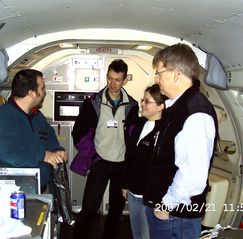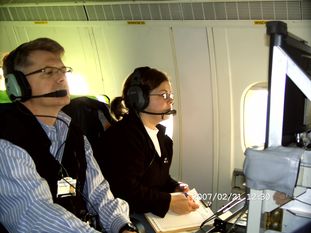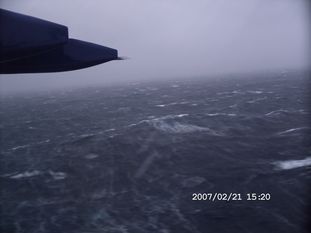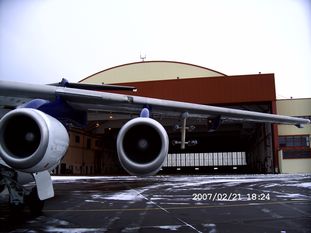

|
|
|||
|
|
|||
|
|
|||
|
|
|||
|
|
|||
|
|
|||
|
|
|||
|
|
|||
 |
|||
Wednesday 21th February - Reverse Tip Jet Flight |
Ground Team
| Today got off to a smooth start when FAAM announced at the 8:15am flight briefing meeting that the Canadians wouldn’t let us use their airspace, and consequently we would have to fly at 18,000ft (Greenland’s airspace) west of 30W rather than the planned 28,000ft (Canadian airspace). The crew and scientists for the first flight departed the hotel on time, and with Haraldur making a trip to the airport to deliver a misplaced boarding pass to a person who shall again remain nameless (Nina), they got off on time. |
| Today we had our first glimpse of the white stuff. This caused great excitement for Emma and Dave, the British members of the exploratory party of PhD students on the hunt for a shop selling printer paper (note for future search parties: go left after Subway), whilst Norwegian Ivan made plans to go swimming in the outdoor pool as soon as he’d finished his work! Back in the warmth of the hotel, flight planning for tomorrow’s flight to the east of Iceland continued with revisions made after the supposed 2hr flight turned into a 6hr flight. |
Airborne Team
| The day started with an early breakfast and an 8:15am weather briefing given by Ian. An update on the day’s flight plan was given, getting everyone excited for the expedition’s first flight to study a reverse tip jet. Six scientists (Ian, Kent, Nina, Stephen, Carling and Tadayasu) set off for the airport after the briefing where they went through security before proceeding to the aircraft in the beautiful High-Viz jackets! After everyone, well not everyone (Nina), handed in their boarding passes the crew was ready for takeoff. | ||||
The 1.5hr flight from Keflavik to Greenland went smoothly, giving all onboard time to familiarize them selves with the aircraft and the instruments. Pictures were taken from all windows of the beautiful clouds below. Upon arriving at 62˚N, 40˚W the aircraft traveled perpendicular to the jet in the first straight level run. The first dropsonde was released through thin cirrus clouds, followed by three more dropsondes during this first high-level run. The aircraft then headed south perpendicular to the jet axes, releasing four more dropsondes. Transmitted data recorded 30m/s second winds at 900mb, with the depth of the jet increasing towars the south. The last high-level run took place perpendicular to the jet axis from 60˚N, 43˚W to 59.5˚N,41˚W. The last four dropsondes were released recording 49m/s winds at a height of 930mb! |
||||
Upon completion of this leg, the aircraft began its descent to low level. With everyone strapped into their seats and holding onto their arm rests, we cut across the jet at a height of approximately 100ft. Turbulence set in, and while the more experienced flyers were at ease in their seats, two of the newbie’s weren’t so lucky. As the roaring sea loomed below us, the aircraft headed north before turning east for the final low-level leg. When stomachs started to churn the pilots began the ascent, maybe a little too late for some, and we began our smooth flight home. |
||||
Back in Keflavik, the team was greeted by freshly fallen snow and four snow plows clearing the way. Definitely royal treatment! A flight debrief was followed by a flight briefing for the next day by those scientists who spent the day in the command centre. The successful flight along with improved internet access left everyone with a smile on their face as we fell exhausted into bed. |
||||



